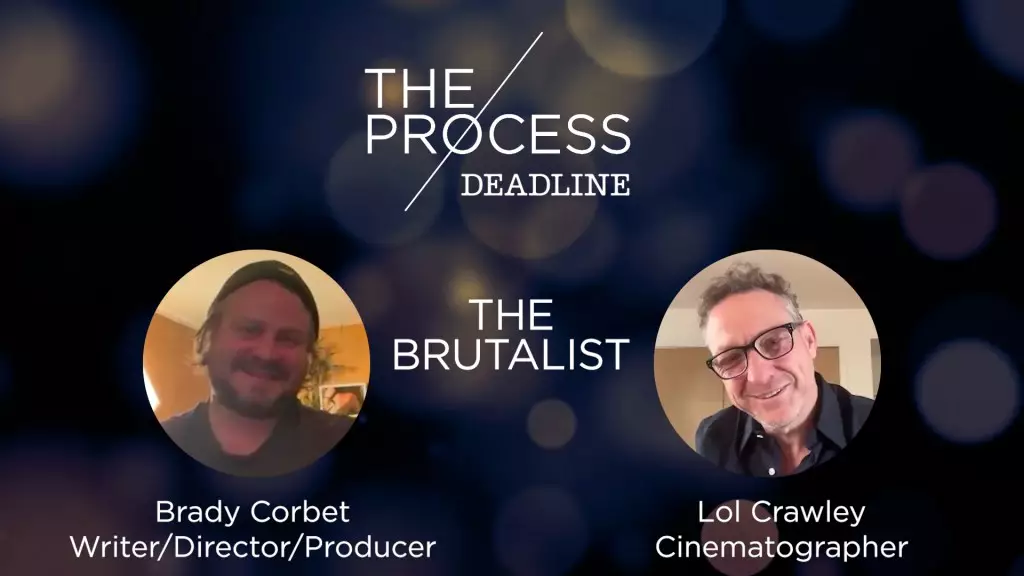Brady Corbet and Lol Crawley have carved a unique niche in cinema with their collaborative efforts over the past decade. Following their works, *Vox Lux* and *The Childhood of a Leader*, their latest joint endeavor, *The Brutalist*, showcases the intricacies of their artistic synergy. In a recent interview for Deadline’s video series *The Process*, Corbet highlights the dual perception of ambition in their films, illuminating how their projects can evoke a spectrum of reactions ranging from admiration to skepticism. The interplay between ambition and personal storytelling lies at the heart of Corbet’s creative process, as he seeks to balance expansive cinematic ideas with the intimate, character-driven narratives that define his work.
What stands out in Corbet’s reflection is his acknowledgment of the collaborative nature of filmmaking. He articulately describes the transformation his scripts undergo from the page to the screen, which he likens to expanding a small, confined circle into a grand canvas. It is within this pre-production phase, steeped in collaboration with diverse talents across various departments, that the grandiosity of the project materializes. Corbet’s confidence in this transformative process reveals a mature understanding of filmmaking, where every contributor plays a vital role in the final incarnation of the film.
Crawley responds to Corbet’s insights with an emphasis on the visual narrative aspects that distinguish *The Brutalist*. He articulates the power of cinematic language, focusing on how pivotal shots and expansive scenes must harmonize with the emotional gravitas of the performances. This focus on the dual significance of space and performance establishes a foundational element of their collective vision, where ambition isn’t merely about scale but also deeply about how stories are visually told.
The essence of “cinematic language,” often an overused term, is refreshed through Crawley’s perspective. In their collaboration, ambitious ideas are distilled into powerful single shots. This method successfully encapsulates not just the visual grandeur but also the emotional weight characters carry through the narrative. The process becomes more than just capturing scenes; it transforms into a dialogue between the visual components and the actors, amplifying the film’s storytelling.
While the conversation inherently celebrates the artistry involved in filmmaking, it does not shy away from the often unforgiving reality of a film set. Corbet’s candid remarks about the exhausting nature of production underscore a truth frequently overlooked by audiences: the relentless pace and pressure exerted on those behind the scenes. His description of a film set as a collection of weary strangers illustrates the dissonance between the glamorous image of filmmaking and its grueling reality.
Crawley contributes to this depiction with a humorous but earnest observation about the flawed charm of being on set. The repetitive and intense environment can appear alien to outsiders, who might struggle to grasp the passion and desperation that fuel its inhabitants. Together, they portray a nuanced representation of what filmmaking entails, blending the beauty of creation with the challenges that accompany it.
Set against the backdrop of post-World War II, *The Brutalist* narrates the poignant journey of László Tóth (played by Adrien Brody), a Hungarian-Jewish architect seeking to rebuild his life after the horrors of the Holocaust. The emotional stakes are elevated as Tóth awaits the arrival of his wife, Erzs é bet (Felicity Jones), who remains stranded in Eastern Europe. This personal story is pivotal, encapsulating themes of resilience, identity, and hope amid adversity.
Beyond the performances of renowned actors such as Joe Alwyn, Stacy Martin, and Emma Laird, *The Brutalist* has garnered critical acclaim, showcasing its potential through accolades like a Golden Globe win for Best Motion Picture Drama and multiple nominations for the Oscars and BAFTAs. This recognition reinforces the film’s impactful storytelling and artistic merits, placing it as a significant contender in contemporary cinema.
*The Brutalist* stands as a testament to the creative visions of Brady Corbet and Lol Crawley, exploring the ambitious landscapes of cinema while remaining grounded in character-driven narratives. Their discourse reveals the layered complexity of filmmaking—the indispensable collaboration, the transformative power of visual storytelling, and the stark realities of production. In a world where cinema can both inspire and enlighten, their artistic partnership continues to shape narratives that resonate with audiences across diverse spectrums. Through *The Brutalist*, they invite viewers into a world where ambition meets artistry, reminding us that true storytelling is as much about the journey as it is about the destination.

Leave a Reply